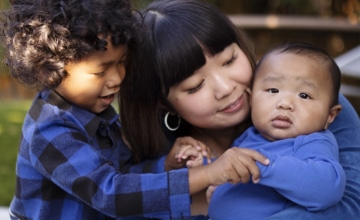Developing self-control begins at birth and continues throughout childhood. Learn what you can do to help your toddler develop and practice self-control.
In order to follow rules and understand limits, children need to develop self-control. Self-control is the ability to cope with strong feelings and stop one’s self from doing something that is not allowed. Developing self-control begins at birth and continues throughout childhood. Young children learn self-control through interactions with loving adults and peers.
Young Toddlers and Self-Control
Toddlers express their strong feelings loud and clear. “No!” becomes a favorite word. Toddlers can also become frustrated easily because there are still many things that they want to do but cannot. Here is an example of how toddlers learn self-control:
A 15-month-old tosses his toy truck across the room. He starts to laugh at the big crash it makes. When his caregiver calls his name in a not-happy voice, he turns with a surprised look on his face. “No throwing trucks,” she tells him, and hands him the truck. “You can push the truck or roll it.” He throws it again and looks at his caregiver to see what will happen. “The rule is no throwing trucks. I am going to put this truck away for a little while. Why don’t you try throwing this soft ball instead?” He cries for a little while but, when he sees he is not getting the truck back, he happily starts throwing the ball.
Young toddlers still lack self-control and don’t have the memory to remember rules and limits. You help them develop self-control by patiently repeating rules and gently distracting them with another activity.
What You Can Do:
- Stop the behavior. For example, firmly take the child’s hand and tell her in a serious voice: No hitting. Hitting hurts.
- Help the child calm down. When a child breaks down, he is telling you he cannot cope. When you comfort him, you help him learn how to eventually soothe himself. Keep in mind that some children need space to calm down. Creating a safe place where children can take a break—where there are soothing objects like stuffed animals, pillows, books—can be very helpful.
- Label the child’s feelings. This makes her feel understood and helps her calm down. You are so angry that Paolo took your toy. It’s okay to feel angry. But you cannot hit. Hitting hurts.
- Offer appropriate ways to express feelings, such as using her words if she is verbal, or other strategies such as drawing a picture about her feelings or hitting a pillow, if this is acceptable to you and her parent(s).
- Help the child solve the problem. For example, go over to Paolo together and ask for the toy back. Use a timer to help the children take turns.




